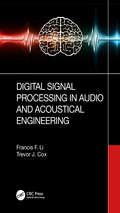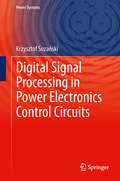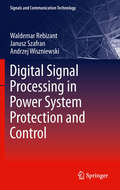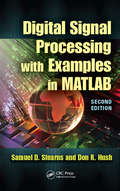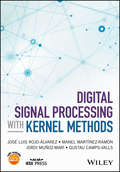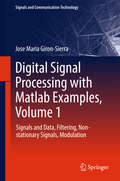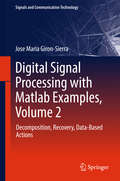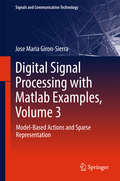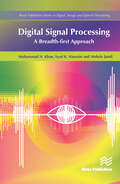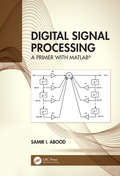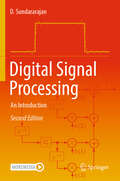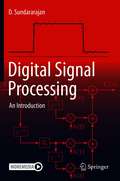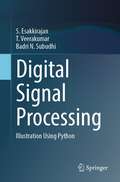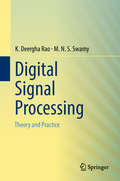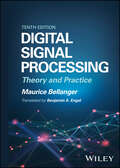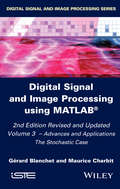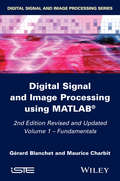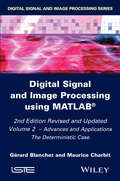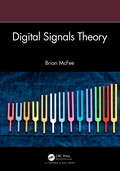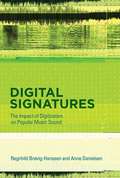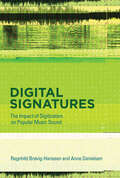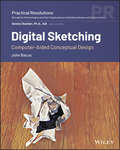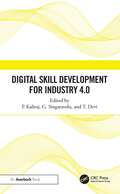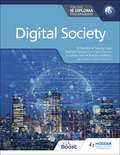- Table View
- List View
Digital Signal Processing in Audio and Acoustical Engineering
by Francis F. Li Trevor J. CoxStarting with essential maths, fundamentals of signals and systems, and classical concepts of DSP, this book presents, from an application-oriented perspective, modern concepts and methods of DSP including machine learning for audio acoustics and engineering. Content highlights include but are not limited to room acoustic parameter measurements, filter design, codecs, machine learning for audio pattern recognition and machine audition, spatial audio, array technologies and hearing aids. Some research outcomes are fed into book as worked examples. As a research informed text, the book attempts to present DSP and machine learning from a new and more relevant angle to acousticians and audio engineers. Some MATLAB® codes or frameworks of algorithms are given as downloads available on the CRC Press website. Suggested exploration and mini project ideas are given for "proof of concept" type of exercises and directions for further study and investigation. The book is intended for researchers, professionals, and senior year students in the field of audio acoustics.
Digital Signal Processing in Power Electronics Control Circuits
by Krzysztof SozańskiMany digital control circuits in current literature are described using analog transmittance. This may not always be acceptable, especially if the sampling frequency and power transistor switching frequencies are close to the band of interest. Therefore, a digital circuit is considered as a digital controller rather than an analog circuit. This helps to avoid errors and instability in high frequency components. Digital Signal Processing in Power Electronics Control Circuits covers problems concerning the design and realization of digital control algorithms for power electronics circuits using digital signal processing (DSP) methods. This book bridges the gap between power electronics and DSP. The following realizations of digital control circuits are considered: digital signal processors, microprocessors, microcontrollers, programmable digital circuits. Discussed in this book is signal processing, starting from analog signal acquisition, through its conversion to digital form, methods of its filtration and separation, and ending with pulse control of output power transistors. The book is focused on two applications for the considered methods of digital signal processing: an active power filter and a digital class D power amplifier. The major benefit to readers is the acquisition of specific knowledge concerning discussions on the processing of signals from voltage or current sensors using a digital signal processor and to the signals controlling the output inverter transistors. Included are some Matlab examples for illustration of the considered problems.
Digital Signal Processing in Power System Protection and Control
by Janusz Szafran Waldemar Rebizant Andrzej WiszniewskiDigital Signal Processing in Power System Protection and Control bridges the gap between the theory of protection and control and the practical applications of protection equipment. Understanding how protection functions is crucial not only for equipment developers and manufacturers, but also for their users who need to install, set and operate the protection devices in an appropriate manner. After introductory chapters related to protection technology and functions, Digital Signal Processing in Power System Protection and Control presents the digital algorithms for signal filtering, followed by measurement algorithms of the most commonly-used protection criteria values and decision-making methods in protective relays. A large part of the book is devoted to the basic theory and applications of artificial intelligence techniques for protection and control. Fuzzy logic based schemes, artificial neural networks, expert systems and genetic algorithms with their advantages and drawbacks are discussed. AI techniques are compared and it is also shown how they can be combined to eliminate the disadvantages and magnify the useful features of particular techniques. The information provided in Digital Signal Processing in Power System Protection and Control can be useful for protection engineers working in utilities at various levels of the electricity network, as well as for students of electrical engineering, especially electrical power engineering. It may also be helpful for other readers who want to get acquainted with and to apply the filtering, measuring and decision-making algorithms for purposes other than protection and control, everywhere fast and on-line signal analysis is needed for proper functioning of the apparatus.
Digital Signal Processing with Examples in MATLAB
by Samuel D. Stearns Donald R. HushBased on fundamental principles from mathematics, linear systems, and signal analysis, digital signal processing (DSP) algorithms are useful for extracting information from signals collected all around us. Combined with today's powerful computing capabilities, they can be used in a wide range of application areas, including engineering, communicati
Digital Signal Processing with Kernel Methods
by José Luis Rojo-Álvarez Manel Martínez-Ramón Jordi Muñoz-Marí Gustau Camps-VallsA realistic and comprehensive review of joint approaches to machine learning and signal processing algorithms, with application to communications, multimedia, and biomedical engineering systems Digital Signal Processing with Kernel Methods reviews the milestones in the mixing of classical digital signal processing models and advanced kernel machines statistical learning tools. It explains the fundamental concepts from both fields of machine learning and signal processing so that readers can quickly get up to speed in order to begin developing the concepts and application software in their own research. Digital Signal Processing with Kernel Methods provides a comprehensive overview of kernel methods in signal processing, without restriction to any application field. It also offers example applications and detailed benchmarking experiments with real and synthetic datasets throughout. Readers can find further worked examples with Matlab source code on a website developed by the authors. Presents the necessary basic ideas from both digital signal processing and machine learning concepts Reviews the state-of-the-art in SVM algorithms for classification and detection problems in the context of signal processing Surveys advances in kernel signal processing beyond SVM algorithms to present other highly relevant kernel methods for digital signal processing An excellent book for signal processing researchers and practitioners, Digital Signal Processing with Kernel Methods will also appeal to those involved in machine learning and pattern recognition.
Digital Signal Processing with Matlab Examples, Volume 1
by Jose Maria Giron-SierraThis is the first volume in a trilogy on modern Signal Processing. The three books provide a concise exposition of signal processing topics, and a guide to support individual practical exploration based on MATLAB programs.This book includes MATLAB codes to illustrate each of the main steps of the theory, offering a self-contained guide suitable for independent study. The code is embedded in the text, helping readers to put into practice the ideas and methods discussed.The book is divided into three parts, the first of which introduces readers to periodic and non-periodic signals. The second part is devoted to filtering, which is an important and commonly used application. The third part addresses more advanced topics, including the analysis of real-world non-stationary signals and data, e.g. structural fatigue, earthquakes, electro-encephalograms, birdsong, etc. The book’s last chapter focuses on modulation, an example of the intentional use of non-stationary signals.
Digital Signal Processing with Matlab Examples, Volume 2
by Jose Maria Giron-SierraThis is the second volume in a trilogy on modern Signal Processing. The three books provide a concise exposition of signal processing topics, and a guide to support individual practical exploration based on MATLAB programs.This second book focuses on recent developments in response to the demands of new digital technologies. It is divided into two parts: the first part includes four chapters on the decomposition and recovery of signals, with special emphasis on images. In turn, the second part includes three chapters and addresses important data-based actions, such as adaptive filtering, experimental modeling, and classification.
Digital Signal Processing with Matlab Examples, Volume 3
by Jose Maria Giron-SierraThis is the third volume in a trilogy on modern Signal Processing. The three books provide a concise exposition of signal processing topics, and a guide to support individual practical exploration based on MATLAB programs. This book includes MATLAB codes to illustrate each of the main steps of the theory, offering a self-contained guide suitable for independent study. The code is embedded in the text, helping readers to put into practice the ideas and methods discussed. The book primarily focuses on filter banks, wavelets, and images. While the Fourier transform is adequate for periodic signals, wavelets are more suitable for other cases, such as short-duration signals: bursts, spikes, tweets, lung sounds, etc. Both Fourier and wavelet transforms decompose signals into components. Further, both are also invertible, so the original signals can be recovered from their components. Compressed sensing has emerged as a promising idea. One of the intended applications is networked devices or sensors, which are now becoming a reality; accordingly, this topic is also addressed. A selection of experiments that demonstrate image denoising applications are also included. In the interest of reader-friendliness, the longer programs have been grouped in an appendix; further, a second appendix on optimization has been added to supplement the content of the last chapter.
Digital Signal Processing: A Breadth-First Approach
by Muhammad Khan Syed K. Hasnain Mohsin JamilThe subject of Digital Signal Processing (DSP) is enormously complex, involving many concepts, probabilities, and signal processing that are woven together in an intricate manner. To cope with this scope and complexity, many DSP texts are often organized around the “numerical examples” of a communication system. With such organization, readers can see through the complexity of DSP, they learn about the distinct concepts and protocols in one part of the communication system while seeing the big picture of how all parts fit together. From a pedagogical perspective, our personal experience has been that such approach indeed works well.Based on the authors’ extensive experience in teaching and research, Digital Signal Processing: a breadth-first approach is written with the reader in mind. The book is intended for a course on digital signal processing, for seniors and undergraduate students. The subject has high popularity in the field of electrical and computer engineering, and the authors consider all the needs and tools used in analysis and design of discrete time systems for signal processing.Key features of the book include:• The extensive use of MATLAB based examples to illustrate how to solve signal processing problems. The textbook includes a wealth of problems, with solutions• Worked-out examples have been included to explain new and difficult concepts, which help to expose the reader to real-life signal processing problems• The inclusion of FIR and IIR filter design further enrich the contents
Digital Signal Processing: A Primer With MATLAB®
by Samir I. AboodDigital Signal Processing:A Primer with MATLAB® provides excellent coverage of discrete-time signals and systems. At the beginning of each chapter, an abstract states the chapter objectives. All principles are also presented in a lucid, logical, step-by-step approach. As much as possible, the authors avoid wordiness and detail overload that could hide concepts and impede understanding. In recognition of requirements by the Accreditation Board for Engineering and Technology (ABET) on integrating computer tools, the use of MATLAB® is encouraged in a student-friendly manner. MATLAB is introduced in Appendix C and applied gradually throughout the book. Each illustrative example is immediately followed by practice problems along with its answer. Students can follow the example step-by-step to solve the practice problems without flipping pages or looking at the end of the book for answers. These practice problems test students' comprehension and reinforce key concepts before moving onto the next section. Toward the end of each chapter, the authors discuss some application aspects of the concepts covered in the chapter. The material covered in the chapter is applied to at least one or two practical problems. It helps students see how the concepts are used in real-life situations. Also, thoroughly worked examples are given liberally at the end of every section. These examples give students a solid grasp of the solutions as well as the confidence to solve similar problems themselves. Some of hte problems are solved in two or three ways to facilitate a deeper understanding and comparison of different approaches. Designed for a three-hour semester course, Digital Signal Processing:A Primer with MATLAB® is intended as a textbook for a senior-level undergraduate student in electrical and computer engineering. The prerequisites for a course based on this book are knowledge of standard mathematics, including calculus and complex numbers.
Digital Signal Processing: An Introduction
by D. SundararajanThis textbook for a one semester introductory course in digital signal processing for senior undergraduate and first year graduate students in electrical and computer engineering departments is concise, highly readable, and yet provides comprehensive coverage of the topic. Each new topic is presented with examples and figures. The highly mathematical content of the topic is presented lucidly to make the learning the subject easier. Practical aspects of the subject are clearly indicated so that the student can apply the principles in real applications. Matlab programs for FIR and IIR filter design are provided as supplementary material online.
Digital Signal Processing: An Introduction
by Dr. D. SundararajanThis textbook for a one semester introductory course in digital signal processing for senior undergraduate and first year graduate students in electrical and computer engineering departments is concise, highly readable, and yet provides comprehensive coverage of the topic. Each new topic is presented with examples and figures. The highly mathematical content of the topic is presented lucidly to make the learning the subject easier. Practical aspects of the subject are clearly indicated so that the student can apply the principles in real applications. Matlab programs for FIR filter design are provided as supplementary material online.
Digital Signal Processing: Illustration Using Python
by S Esakkirajan T Veerakumar Badri N SubudhiDigital signal processing deals with extraction of useful information from signals. Signal processing algorithms help observe, analyse and transform signals. The objective of this book is to develop signal processing algorithms using Python. Python is an interpreted, object-oriented high-level programming language widely used in various software development fields such as data science, machine learning, web development and more. Digital Signal Laboratory is playing an important role in realizing signal processing algorithms, utilizing different software solutions. The intention of this textbook is to implement signal processing algorithms using Python. Since Python is an open-source language, students, researchers, and faculty can install and work with it without spending money, reducing the financial burden on institutions. Each chapter in this book begins with prelab questions, a set of Python examples to illustrate the concepts, exercises to strengthen the understanding of the concepts, and objective questions to help students prepare for competitive examinations. This book serves as an undergraduate textbook, it can be used for individual study, and it can also be used as the textbook for related courses.
Digital Signal Processing: Theory And Practice
by K. Deergha Rao M.N.S. SwamyThe book provides a comprehensive exposition of all major topics in digital signal processing (DSP). With numerous illustrative examples for easy understanding of the topics, it also includes MATLAB-based examples with codes in order to encourage the readers to become more confident of the fundamentals and to gain insights into DSP. Further, it presents real-world signal processing design problems using MATLAB and programmable DSP processors. In addition to problems that require analytical solutions, it discusses problems that require solutions using MATLAB at the end of each chapter.Divided into 13 chapters, it addresses many emerging topics, which are not typically found in advanced texts on DSP. It includes a chapter on adaptive digital filters used in the signal processing problems for faster acceptable results in the presence of changing environments and changing system requirements. Moreover, it offers an overview of wavelets, enabling readers to easily understand the basics and applications of this powerful mathematical tool for signal and image processing. The final chapter explores DSP processors, which is an area of growing interest for researchers. A valuable resource for undergraduate and graduate students, it can also be used for self-study by researchers, practicing engineers and scientists in electronics, communications, and computer engineering as well as for teaching one- to two-semester courses.
Digital Signal Processing: Theory and Practice
by Maurice BellangerDIGITAL SIGNAL PROCESSING Understand the future of signal processing with the latest edition of this groundbreaking text Signal processing is a key aspect of virtually all engineering fields. Digital techniques enormously expand the possible applications of signal processing, forming a part of not only conventional engineering projects but also data analysis and artificial intelligence. There are considerable challenges raised by these techniques, however, as the gulf between theory and practice can be wide; the successful integration of digital signal processing techniques requires engineers capable of bridging this gulf. For years, Digital Signal Processing has met this need with a comprehensive guide that consistently connects abstract theory with practical applications. Now fully updated to reflect the most recent developments in this crucial field, the tenth* edition of this seminal text promises to foster a broader understanding of signal processing among a new generation of engineers and researchers. Readers of the new edition of Digital Signal Processing will also find: Exercises at the end of each chapter to reinforce key conceptsA new chapter covering digital signal processing for neural networksHandy structure beginning with undergraduate-level material before moving to more advanced concepts in the second half Digital Signal Processing is a must-own for students, researchers, and industry professionals in any of the hundreds of fields and subfields that make use of signal processing algorithms. *This is the English language translation of the French original Traitement Numérique du Signal 10th edition by Maurice Bellanger © Dunod 2022 and is the 4th edition in English.
Digital Signal and Image Processing using MATLAB
by Gérard Blanchet Maurice CharbitThis title provides the most important theoretical aspects of Image and Signal Processing (ISP) for both deterministic and random signals. The theory is supported by exercises and computer simulations relating to real applications. More than 200 programs and functions are provided in the MATLAB(r) language, with useful comments and guidance, to enable numerical experiments to be carried out, thus allowing readers to develop a deeper understanding of both the theoretical and practical aspects of this subject.
Digital Signal and Image Processing using MATLAB, Volume 1: Fundamentals (Digital Signal And Image Processing Ser.)
by Gérard Blanchet Maurice CharbitThis fully revised and updated second edition presents the most important theoretical aspects of Image and Signal Processing (ISP) for both deterministic and random signals. The theory is supported by exercises and computer simulations relating to real applications. More than 200 programs and functions are provided in the MATLABÒ language, with useful comments and guidance, to enable numerical experiments to be carried out, thus allowing readers to develop a deeper understanding of both the theoretical and practical aspects of this subject. This fully revised new edition updates : - the introduction to MATLAB programs and functions as well as the Graphically displaying results for 2D displays - Calibration fundamentals for Discrete Time Signals and Sampling in Deterministic signals - image processing by modifying the contrast - also added are examples and exercises.
Digital Signal and Image Processing using MATLAB, Volume 2
by Gérard Blanchet Maurice CharbitThe most important theoretical aspects of Image and SignalProcessing (ISP) for both deterministic and random signals, thetheory being supported by exercises and computer simulationsrelating to real applications. More than 200 programs and functions are provided in theMATLAB® language, with useful comments and guidance, to enablenumerical experiments to be carried out, thus allowing readers todevelop a deeper understanding of both the theoretical andpractical aspects of this subject. Following on from thefirst volume, this second installation takes a more practicalstance, providing readers with the applications of ISP.
Digital Signals Theory
by Brian McFeeWhere most introductory texts to the field of digital signal processing assume a degree of technical knowledge, this class-tested textbook provides a comprehensive introduction to the fundamentals of digital signal processing in a way that is accessible to all. Beginning from the first principles, readers will learn how signals are acquired, represented, analyzed and transformed by digital computers. Specific attention is given to digital sampling, discrete Fourier analysis and linear filtering in the time and frequency domains. All concepts are introduced practically and theoretically, combining intuitive illustrations, mathematical derivations and software implementations written in the Python programming language. Practical exercises are included at the end of each chapter to test readers’ knowledge. Written in a clear and accessible style, this book is particularly aimed at students and general readers interested in audio and digital signal processing but who may not have extensive mathematical or engineering training.
Digital Signatures: The Impact of Digitization on Popular Music Sound
by Anne Danielsen Ragnhild Brøvig-HanssenIs digital production killing the soul of music? Is Auto-Tune the nadir of creative expression? Digital technology has changed not only how music is produced, distributed, and consumed but also -- equally important but not often considered -- how music sounds. In this book, Ragnhild Brøvig-Hanssen and Anne Danielsen examine the impact of digitization on the aesthetics of popular music. They investigate sonically distinctive "digital signatures" -- musical moments when the use of digital technology is revealed to the listener. The particular signatures of digital mediation they examine include digital reverb and delay, MIDI and sampling, digital silence, the virtual cut-and-paste tool, digital glitches, microrhythmic manipulation, and autotuning -- all of which they analyze in specific works by popular artists.Combining technical and historical knowledge of music production with musical analyses, aesthetic interpretations, and theoretical discussions, Brøvig-Hanssen and Danielsen offer unique insights into how digitization has changed the sound of popular music and the listener's experience of it. For example, they show how digital reverb and delay have allowed experimentation with spatiality by analyzing Kate Bush's "Get Out of My House"; they examine the contrast between digital silence and the low-tech noises of tape hiss or vinyl crackle in Portishead's "Stranger"; and they describe the development of Auto-Tune -- at first a tool for pitch correction -- into an artistic effect, citing work by various hip-hop artists, Bon Iver, and Lady Gaga.
Digital Signatures: The Impact of Digitization on Popular Music Sound (The\mit Press Ser.)
by Anne Danielsen Ragnhild Brovig-HanssenHow sonically distinctive digital “signatures”—including reverb, glitches, and autotuning—affect the aesthetics of popular music, analyzed in works by Prince, Lady Gaga, and others. Is digital production killing the soul of music? Is Auto-Tune the nadir of creative expression? Digital technology has changed not only how music is produced, distributed, and consumed but also—equally important but not often considered—how music sounds. In this book, Ragnhild Brøvig-Hanssen and Anne Danielsen examine the impact of digitization on the aesthetics of popular music. They investigate sonically distinctive “digital signatures”—musical moments when the use of digital technology is revealed to the listener. The particular signatures of digital mediation they examine include digital reverb and delay, MIDI and sampling, digital silence, the virtual cut-and-paste tool, digital glitches, microrhythmic manipulation, and autotuning—all of which they analyze in specific works by popular artists.Combining technical and historical knowledge of music production with musical analyses, aesthetic interpretations, and theoretical discussions, Brøvig-Hanssen and Danielsen offer unique insights into how digitization has changed the sound of popular music and the listener's experience of it. For example, they show how digital reverb and delay have allowed experimentation with spatiality by analyzing Kate Bush's “Get Out of My House”; they examine the contrast between digital silence and the low-tech noises of tape hiss or vinyl crackle in Portishead's “Stranger”; and they describe the development of Auto-Tune—at first a tool for pitch correction—into an artistic effect, citing work by various hip-hop artists, Bon Iver, and Lady Gaga.
Digital Sketching: Computer-Aided Conceptual Design (Practical Revolution)
by John BacusLearn to apply new digital design technologies at your own firm with this practical and insightful resource Digital Sketching: Computer-Aided Conceptual Design delivers a comprehensive and insightful examination of how architects and other design professionals can best use digital design technology to become better designers. Celebrated professional, professor, and author John Bacus provides readers with practical and timely information on emerging digital design technologies and their effect on professional practice. By focusing on the big picture, this rigorous survey of conceptual design technology offers professionals realistic strategies for reclaiming time for design in the ever increasing speed of project delivery. This book helps architects (and others like them) learn to use digital sketching techniques to be better designers, right from the project’s very first sketch. As part of the groundbreaking Practical Revolutions series of books, Digital Sketching furthers the conversation of the practical deployment of emerging technologies in the building industries. This book provides readers with the information they need to evaluate digital design technology and decide whether or not to adopt and integrate it into their own processes. Readers will receive: An accelerated and accessible introduction to a highly technical topic Practical and applicable guidance on how to adapt a firm’s business to adopt new technology without losing the benefit of existing intuition, skill, and experience. Real world implementations of specific techniques in the form of illuminating case studies that include results and lessons learned Perfect for professional architectural designers, Digital Sketching also belongs on the bookshelves of interior designers, landscape architects, urban planners, contractors, and specialty fabricators of every kind. A disciplined sketching practice, especially through the digital methods discussed in this book, is a transformational benefit to anyone who designs and builds for a living.
Digital Skill Development for Industry 4.0
by P. Kaliraj T. Devi G. SingaraveluThe Fourth Industrial Revolution, Industry 4.0, is changing the world, and digital transformation technology tools have impacted every walk of life. The nature of work and careers is changing fast – and in the future, the right skills will be prized over academic qualifications. Students must develop various skills, especially technology skills, to become the workforce of the future; the onus of developing these skills falls on educational institutions. The development of innovation and ideation skills in students is a must for them to productively contribute to a future economy. They should have the capability to translate ideas into solutions, products, and systems that are scalable, practically feasible, and adaptable.To prepare students for this digital world, Digital Skill Development for Industry 4.0 contains chapters on developing: Professional skills, cognitive learning Critical thinking skills among modern learners Motivation and student engagement Invoking interest of students Student engagement in e-learning Contextual learning Experimental learning Multidisciplinary learning The book is written for the academic and administrative community of universities and colleges who intend to equip their modern learners with the skills of Industry 4.0. It is also useful as a reference for undergraduate and postgraduate courses, as well as doctoral programs. The book can also serve as a comprehensive reference guide for researchers in the development of tools incorporating new skills and technologies. Practitioners who are interested in introducing digital skill development for Industry 4.0 and its tools to solve real‑world problems can also use this book.
Digital Society for the IB Diploma
by Michael Fitzpatrick Eli Bomfim Tammy Earle Carol Hancox Jonathon Levin Barbara StefanicsDeveloped in cooperation with the International Baccalaureate®Ensure full coverage of the new Digital Society course with this accessible coursebook written by an experienced international team of IB educators and examiners, enabling students to build skills and understand the importance and impact of digital systems and technologies in the contemporary world.- Explore digital society through the key concepts, content and contexts of the syllabus with clear, real world, internationally-minded examples for each topic.- Delve into the higher-level extension challenges and interventions in digital society using contemporary,real-world issues that allow students to formulate their own recommendations, with chapter reflections to consolidate learning throughout.- Essential tools for inquiry are integrated throughout the course, with links to ATL, TOK, and extended essay.- Specific chapters and activities are featured for conducting inquiries suitable for SL and HL students, with added extended inquiries for HL students.- Prepare for the inquiry project with step-by-step guidance, advice, practice questions and top tips onhow to maximise potential in the assessment.
Digital Society for the IB Diploma
by Michael Fitzpatrick Eli Bomfim Tammy Earle Carol Hancox Jonathon Levin Barbara StefanicsDeveloped in cooperation with the International Baccalaureate®Ensure full coverage of the new Digital Society course with this accessible coursebook written by an experienced international team of IB educators and examiners, enabling students to build skills and understand the importance and impact of digital systems and technologies in the contemporary world.- Explore digital society through the key concepts, content and contexts of the syllabus with clear, real world, internationally-minded examples for each topic.- Delve into the higher-level extension challenges and interventions in digital society using contemporary,real-world issues that allow students to formulate their own recommendations, with chapter reflections to consolidate learning throughout.- Essential tools for inquiry are integrated throughout the course, with links to ATL, TOK, and extended essay.- Specific chapters and activities are featured for conducting inquiries suitable for SL and HL students, with added extended inquiries for HL students.- Prepare for the inquiry project with step-by-step guidance, advice, practice questions and top tips onhow to maximise potential in the assessment.
